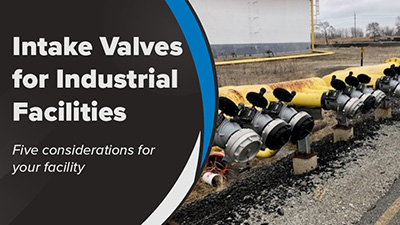5 Intake Valve Considerations for Industrial Facilities and Refineries
Industrial facilities and refineries have a unique set of needs when it comes to water flow. For you, fire suppression means using a high volume of water to mitigate damage and minimize loss. The intake valves you use need to be reliable and ready to be an intake or discharge as they’re used on apparatus, pumps, or ultra-manifolds.
So, what should you consider as you are evaluating and selecting your intake valves?
We’ve put together a list of five things we recommend you evaluate fully when you select the intake valves for your facility.
Large, Unobstructed Waterway
When you need to move large amounts of water, you need a large, unobstructed waterway for the water to move through. This will allow as much water as possible through and minimize the friction loss you experience.
If you use an ultra-manifold, you might be moving as much as 10,000 GPM through multiple valves. To minimize pump strain and get the most bang for your buck, you will want the largest waterway on the market.
TFT’s Jumbo Ball Intake Valve has an unobstructed 5 ¼" (133 mm) waterway that allows for high flow with only 3 PSI of friction loss.
Durability
Most facilities need intake valves outdoors, so you will want to be sure yours can withstand the weather in your area. Not only does the valve construction need to be sturdy and weather resistant, but the internal mechanisms should account for this as well. A valve style that leaves water sitting inside the valve may not be a reliable choice if your area experiences freezing weather.
Some intake valves use a half ball to control the flow of water. This style keeps your valve dry when it isn’t in use, minimizing the chance for ice buildup and damage.
Corrosion Resistance
Corrosion resistance in your intake valve is especially important. For many industrial facilities or refineries, the turbulence caused by high water flow during an emergency stirs up slime growth, sludge, and sediment that rests in the bottom of the pipes. This mixes with the water and travels through your intake valve. If your intake valve is made of the wrong materials or easily corroded, its life span will suffer.
For this reason, and to minimize galvanization, many facilities look for intake valves that use stainless steel parts, especially around the couplings and valve itself. Some manufacturers hard coat anodize the valves or use corrosion resistant coatings to further extend the life of your intake valve. Task Force Tips offers an all-aluminum valve and features an optional stainless-steel upgrade to suit your industrial water quality. The Jumbo Intake Valve series includes a 10-year warranty against manufacturing defects and corrosion that affects the valve’s operational performance.
Pressure Ratings
In an industrial facility, you might use pressures that are higher than would typically be seen on the municipal side of firefighting. The apparatus often has larger pumps and larger piping, and intake valves can often be used as intake and discharge on a larger, external pump.
With these things in mind, you must be sure your chosen intake valve can withstand the pump pressures it may see. It is important to understand the rating of your intake valve and the type of testing that the manufacturer does to ensure it can meet your needs.
Customer Service
No matter how good of an intake valve you choose, something can still go wrong. That is why routine inspections are important. You also need to evaluate and understand the type of customer service you will be getting.
Does your intake valve come with a warranty? Is there a straightforward way to contact the service department for any questions or claims you need to make? What if you need the intake valve resealed? Can you do that on your own or send it back to the manufacturer?
Understanding the service procedures and warranty for your intake valve can make a significant difference in your choice. You should also consider the regular maintenance your intake valve will need and how easy it is for your staff to complete.
Conclusion
When you need to move a lot of water at an industrial facility or refinery, you need an intake valve that can keep up with the demands of the job. Whether those demands are high flow, weather, low water quality, or higher pressure, it is important to compare your options and make the choice that works best for you.
